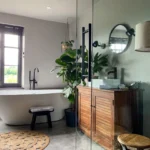A beamed ceiling has long been a defining feature of inviting and stylish living rooms. The warmth and architectural charm that wooden beams provide can transform an ordinary space into one that is full of character and depth. Whether your home leans toward rustic, modern, or traditional aesthetics, these ceilings serve as a striking focal point while offering practical benefits such as enhancing the perception of height and providing structural reinforcement.
The Appeal of Beamed Ceilings in Living Rooms
The inclusion of a beamed ceiling in a living room can dramatically influence the ambiance and functionality of the space. Beyond their aesthetic value, beams introduce texture, visual interest, and a sense of history. They can help define areas within an open floor plan, create symmetry, and even conceal wiring or structural support elements.
Key reasons homeowners opt for this feature include:
- Architectural Significance – Whether reclaimed barn wood or sleek, engineered beams, they add depth and historical charm.
- Versatile Design Integration – Beams suit farmhouse, industrial, transitional, and even minimalist interiors.
- Enhanced Ceiling Perception – Drawing the eye upwards creates an illusion of spaciousness.
- Potential for Decorative and Functional Use – Beyond visual appeal, beams can house recessed lighting, integrate with vaulted ceilings, or help hide imperfections.
Popular Materials for Beamed Ceilings
Choosing the right material for your beamed ceiling is essential for both aesthetics and durability. Materials vary in price, maintenance needs, and visual impact.
Solid Wood Beams
Solid wood beams, often crafted from oak, pine, or cedar, provide an authentic, rustic appearance. They are ideal for homeowners desiring natural grain patterns and organic warmth. However, they can be heavy and require substantial structural support, making them more suitable for renovations with strong existing frameworks.
Faux Wood Beams
For those who appreciate the look of real wood without the weight or cost, faux wood beams made from polyurethane serve as an excellent alternative. They mimic genuine timber while being more affordable and easier to install. They are also resistant to warping and cracking, making them a practical solution for various environments.
Reclaimed Wood Beams
Homeowners who value sustainability often choose reclaimed wood beams. Salvaged from old barns, factories, or warehouses, these beams bring authenticity and unique character to a living room while reducing environmental impact.
Metal Beams
In modern and industrial-style homes, exposed steel or aluminum beams can offer a sleek, contemporary feel. While traditionally used for support, they can also be incorporated decoratively.
Beamed Ceiling Styles for Every Living Room
Beamed ceilings come in various styles, allowing homeowners to match them with their desired aesthetic.
Exposed Rustic Beams
Popular in farmhouse and cabin-style homes, rustic beams with rough textures and natural imperfections create a cozy and inviting atmosphere. Pairing exposed beams with neutral-toned walls and soft lighting enhances warmth.
Painted Beams for a Contemporary Look
While dark wood beams add a traditional touch, painted beams—typically white or soft gray—blend seamlessly with modern interiors. This approach maintains the architectural appeal while keeping the ceiling light and airy.
Vaulted Ceilings with Beams
If your living room boasts high or cathedral ceilings, beams add a sense of proportion and coziness, preventing the space from feeling cavernous. They also complement dramatic chandeliers or pendant lights.
Contrasting Dark Beams with Light Ceilings
A striking contrast between dark, espresso-hued wooden beams and a crisp, white ceiling makes for a sophisticated design choice. This approach draws attention upward while creating dynamic visual appeal.
Minimalist Floating Beams
Sleek floating ceiling beams with clean lines work well in modern and transitional living rooms. They provide structure without overwhelming the space, allowing for a refined yet warm aesthetic.
Installing a Beamed Ceiling: Considerations and Costs
Before installation, several factors must be evaluated to ensure the ceiling beams complement the space both structurally and visually.
Choosing the Right Beam Size and Placement
- Room Size Matters – Large beams in a small room can feel overpowering, while undersized beams in a spacious living area may look insignificant.
- Spacing and Pattern – Parallel beams create a classic appearance, while crossbeams or coffered layouts contribute to a sophisticated architectural look.
- Ceiling Height Considerations – Lower ceilings benefit from slimmer beams, while vaulted spaces can accommodate more dramatic designs.
Installation Costs
The cost of installing a beamed ceiling varies depending on materials, labor, and ceiling type. Faux beams typically cost $6–$25 per linear foot, making them an economical choice compared to solid wood, which ranges from $15–$90 per linear foot. Factors such as professional installation and structural modifications can further influence expenses.
Decorating a Living Room with Beamed Ceilings
Once installed, styling a living room with a beamed ceiling can enhance its overall appeal.
- Layered Lighting – Chandeliers, recessed lighting, and wall sconces complement exposed beams beautifully, ensuring the ceiling doesn’t darken the space.
- Neutral Color Palettes – Keeping walls and ceilings light creates balance, preventing beams from overpowering the room.
- Natural Elements – Incorporating stone fireplaces, leather furniture, or greenery, such as tall indoor plants for small spaces, harmonizes with wooden beams.
- Textured Rugs and Upholstery – Layering textiles adds softness, contrasting the hard lines of ceiling beams.
Keeping Beamed Ceilings in Good Condition
Proper maintenance ensures that ceiling beams remain a highlight of your living room for years.
- Regular Dusting and Cleaning – Dust can accumulate on beams, especially in high-ceilinged rooms. Use a microfiber cloth or extendable duster to keep surfaces clean.
- Preserving Wooden Beams – Conditioning wood with natural oils or sealants prevents it from drying out or cracking.
- Checking for Structural Stability – If beams are functional rather than decorative, occasional inspections by a professional help maintain integrity.
Conclusion
A beamed ceiling is more than just an architectural feature—it brings depth, warmth, and enduring appeal to a living room. Whether opting for reclaimed wood for a rustic feel, sleek painted beams for a modern touch, or dramatic vaulted designs, these ceilings create focal points that enhance the overall living experience. Thoughtful installation, styling, and maintenance ensure that ceiling beams remain a beloved element in homes for years to come.



